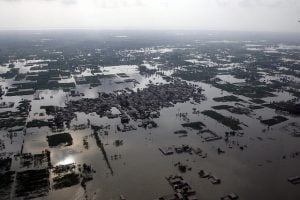Media Meets Climate: The Global Challenge for Journalism
By Elisabeth Eide and Risto Kunelius (eds.)
Published by Nordicom, University of Gothenburg, 2012
Environmental journalists and writers on climate change have had a roller coaster ride over the last decade.
Back at the turn of the century the environment correspondent was something of an oddity, often found in the dimmer reaches of a newsroom, squeezed into a space near the broom cupboard and derisively referred to by more mainstream colleagues as a "tree hugger" – or worse.
Then, spurred on by events such as the long, hot European summer of 2003, climate change suddenly hit the global news agenda in a big way. The warnings contained in reports by the Intergovernmental Panel on Climate Change (IPCC) were headline news. The 2006 Stern Review looking at the economic impacts of climate change brought the issue on to the financial pages. The media tumult reached its height with the Copenhagen summit in late 2009 – a meeting rather immodestly billed by many news outlets as one that would determine the future of the planet.
Then, after the debacle in the Danish capital, all went quiet. The environment correspondent went back to the broom cupboard as what were deemed far weightier matters took hold: the global economic system was near collapse, China and India were on the rise, there were celebrities to worry about and football matches to be won.
Media Meets Climate looks at coverage of successive international climate conferences and questions the role and responsibility of journalism in communicating issues of climate change. The book’s editors lay their cards on the table: “Our work is based on the conviction that climate change is the global challenge of the 21st century.”
Climate change is a global issue but so far international institutions like the UN have proved woefully inadequate at tackling it, with any meaningful progress garotted by narrow national interests or the activities of powerful corporations and lobby groups. Successive summits have bred only pessimism. “In how many ways can you write that nothing’s happening?” asked one frustrated journalist during the 2011 climate summit in Durban.
Writers in this book point out that journalism is also in some ways responsible for the mess we’re in. In the interest of so-called balance, climate change contrarians have often been given far too much publicity. The media has not kept pace with globalisation. Media organisations still think in terms of the domestic rather than a global audience. Even those who claim to be international – the BBC, Al-Jazeera, CNN or The Guardian, FT, Wall Street Journal or China Daily – are influenced in the main by national considerations.
“The fact still remains that most of the global media landscape is still made up of nationally anchored media outlets,” say the authors.
Climate change can be a hard story both to tell and to sell. Scientists are often not the best communicators. Journalists can over-simplify and sensationalise. Summits get lost in a noxious cloud of acronyms. Climate change is at times vague, full of possibles and maybes – not the sort of thing to get an editor’s blood racing. Dramatic pictures of bomb blasts and plane crashes are splashed across the front pages, but pictures of CO2 emissions just don’t make the grade.
This is an exhaustive analysis and, at times, it makes for gloomy reading. We are taken through "Climategate" in the UK, the “profoundly partisan” nature of Australia’s newspapers reporting on the introduction of a carbon tax, and the activities of the naysayers and deniers. The ups and downs of media coverage on climate change are noted: the authors say more than 3,200 stories appeared in the world’s mainstream newspapers concerning events in Copenhagen. At the climate summit in Durban two years later, the number of stories shrank to a quarter that amount.
Media attention might have moved elsewhere, yet with each passing day the climate change issue is becoming ever more serious.
“Must try harder” is writ large on the media report card.

